

After receiving each pair of drivers, I connected them to my test amp and allowed them to play music from the radio for 5 days (120 hours) at a volume level that generated visible motions of the main cone and pushed the drivers to +/- 1 mm deflection (Xmax) during bass heavy passages. After this break-in period, I measured the T/S parameters, the impedance, the on axis SPL response, and the off axis SPL response for each driver. The test set-up, and post processing procedure, is described and detailed results for the DX2, DX3, and DX4 drivers are included. Summarized below are the average Thiele-Small parameters for the three different models of DX drivers.
| Parameter | DX2 | DX3 | DX4 | Units |
| fd | 55.6 | 60.5 | 59.7 | Hz |
| Qed | 0.33 | 0.26 | 0.22 | |
| Qmd | 4.02 | 3.83 | 3.64 | |
| Qtd | 0.30 | 0.24 | 0.21 | |
| Re | 7.10 | 7.10 | 7.10 | ohms |
| BL | 9.08 | 10.27 | 10.43 | Tesla-m |
| Vad | 45.1 | 41.1 | 46.2 | liters |
| Sd | 206 | 206 | 206 | cm^2 |
| SPL | 95.6 | 97.4 | 98.3 | dB |
A couple of observations can be made after reviewing the test data for each of the three DX drivers. The first thing that stands out is the 10 dB increase in the on axis SPL between 6 and 12 kHz. This appears to be a very directional SPL response due to whizzer cone resonances. The SPL response 30 degrees off axis does not show this elevated output. If you look at the corresponding impedance plots, phase changes typically associated with resonances also appear between 6 and 12 kHz. These phase changes become more prominant in the impedance plots as the magnet strength increases and are most easily seen for the DX4 drivers. For this range of frequencies the impedance of a full range driver can usually be represented by a frequency dependent voice coil resistance and inductance. The phase changes must be generated by a back emf arising from fluctuations in the voice coil velocity as the whizzer cone resonates.
One more observation is worth noting while looking at these impedance plots. There does not appear to be a significant voice coil inductance contribution at the higher frequencies. The impedance magnitude is very flat, almost constant. The significance of this will be seen when designing a baffle step correction circuit, a Zobel circuit may not be required across the voice coil terminals to cancel a rising voice coil inductive impedance. The lack of a Zobel circuit will reduce the number of passive circuit elements and simplify the wiring required inside the enclosure.
I anticipated that the stronger magnets would decrease the Qts and increase the efficiency, which was correct, and also extend the high frequency response. Plotting the SPL's measured for the DX drivers, on the same graphs, the following four plots show the on axis and off axis response results for Driver #1 and Driver #2.
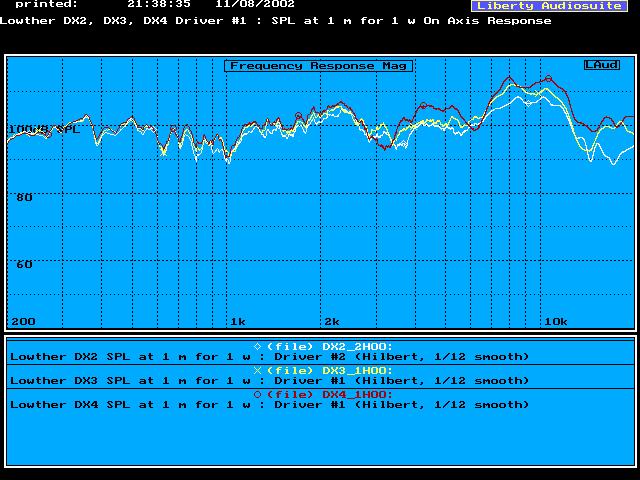
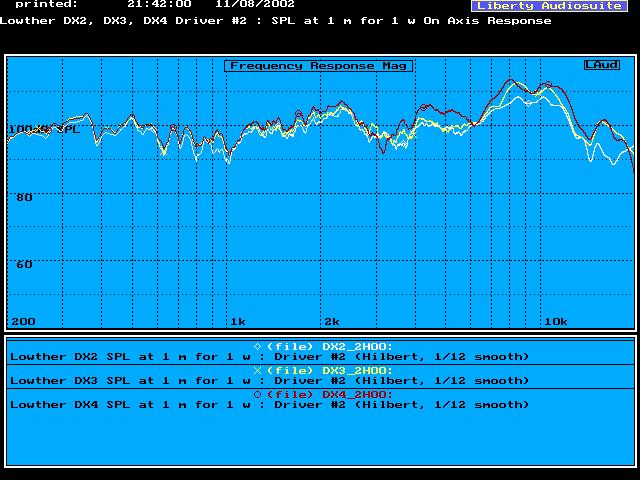
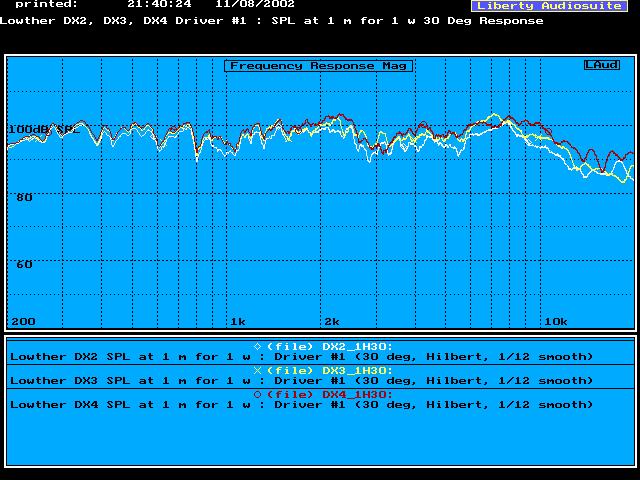
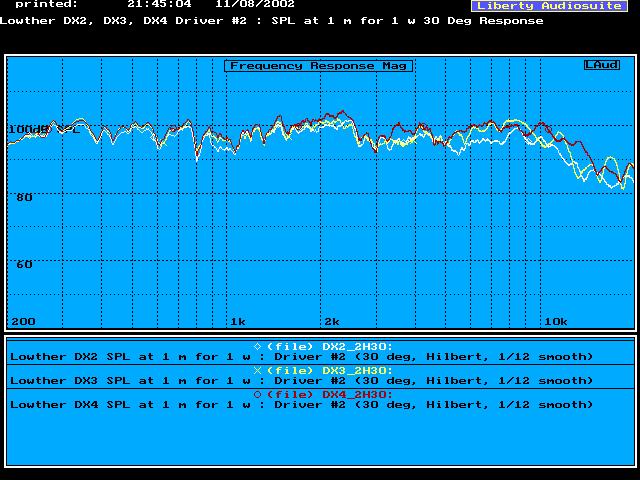
The general characteristics of these curves are very similar for all three DX drivers. The SPL response between 200 Hz and 1 kHz is almost the same for all three DX drivers. Above 3 kHz, as the magnet strength of the driver increases, the on axis frequency response appears to tilt upward but does not extend any higher. Off axis, the responses look almost the same except an increase in efficiency for the drivers with the larger magnets. Looking closer at the off axis SPL responses, the differences become slightly larger as the frequency increases which is consistent with the upward tilt seen in the on axis SPL responses as the magnets get stronger.
Another difference that I investigated was the influence the phase plug has on the SPL response. I selected DX4 Driver #1 to test the different phase plug options. This particular driver had the highest frequency extension of all six DX drivers. The following plots compare the on axis and off axis SPL responses without a phase plug, with the bullet phase plug, and with the original "shower head" phase plug.
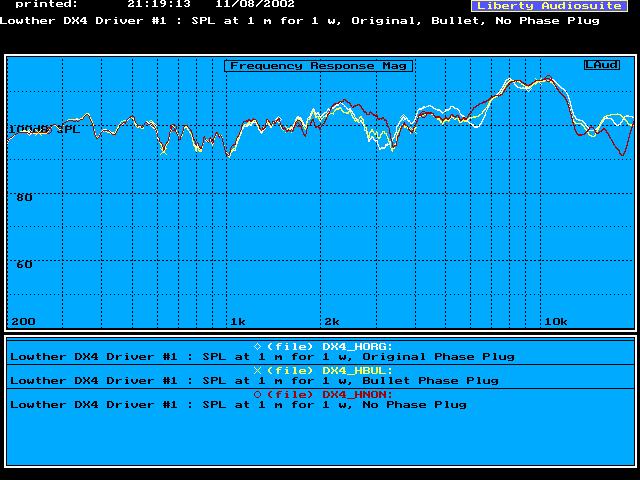
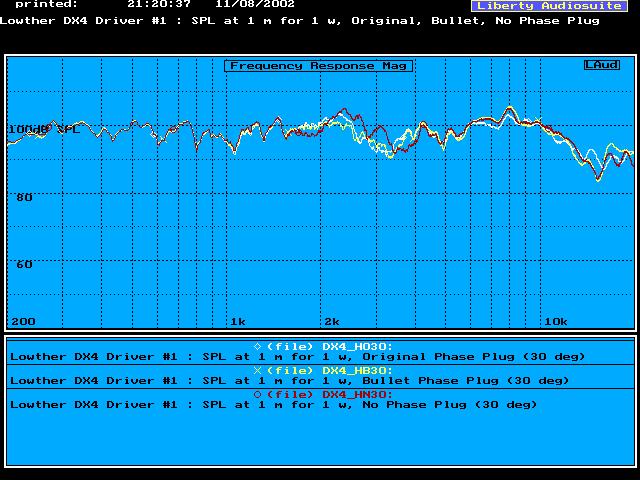
There does not appear to be a consistent difference, at all frequencies, in the performance of a Lowther DX series driver with or without a phase plug. Below 2 kHz, the three phase plug options perform almost exactly the same. Above 2 kHz, there are differences in certain limited frequency ranges but they are not consistent over the entire frequency range between 2 and 20 kHz. There does not seem to be a significant trend attributable to one of the phase plug options over the extended frequency range between 2 kHz to 20 kHz. The phase plug options have the biggest impact on the frequency range between 2 and 6 kHz. I will reserve final judgement on the sound of the various phase plug options until I listen to a finished speaker system.
Some alternate phase plug measurements have been been made by Jean-Philippe Bondy using a Lowther DX3 driver and some creativity. These plots show that the peaks in the on axis response of Lowther drivers can be significantly smoothed using the right phase plug geometry.
Measurements have characterized the potential low frequency performance by determining the Thiele-Small parameters of the three DX series drivers. This is the data that will be used to design the enclosures needed to augment the naturally rolled-off bass response of the drivers.
The midrange responses of the three drivers, spanning the frequency range 200 Hz to 2 kHz, are very similar with only slight differences in efficiency. The 1 or 2 dB differences in efficiency are also predicted by the Thiele-Small parameter measurements.
At the higher frequencies, above 2 kHz, the three driver responses diverge as the stronger magnets create a slight upward tilt of the SPL response. In addition, all three DX driver models exhibit a very directional 10 dB increase in the on axis SPL output between 6 and 12 kHz. Listening slightly off axis will probably cure this 10 dB SPL response anomoly.
These measurements will be used to design the enclosure and any required filtering needed to correct or rebalance SPL response problems. But the measurements do not always indicate how the final system will sound. While running these drivers on the bench, I had a chance to form some initial impressions. I heard a lot of potential while listening to these Lowther DX series drivers in this far from optimal condition.